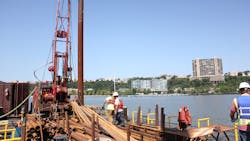New phase of work begins in Hudson River as engineering advances on Gateway Hudson Tunnel Project
The Gateway Program partners will be conducting dozens of geotechnical borings along the proposed alignment of the new tunnel to continue to advance the engineering and design of the Hudson Tunnel Project.
The exploration, which began in October and is expected to run through early 2020, will include 36 geotechnical borings covering both river- and land-based locations and extending to depths ranging from 55 feet to 280 feet, four seismic Cone Penetration Tests, a bathymetric survey in the Hudson River and a surface-based geophysical survey along the Hudson Bergen Light Rail (HBLR) tracks in New Jersey.
The work is endorsed by the Gateway Program Development Corporation (GDC) and is being implemented by Amtrak, consistent with Amtrak’s prior and ongoing support it has provided for preliminary engineering of the project. The information gathered will help engineers better understand geotechnical characteristics of the Hudson River, New Jersey Palisades and the west side of Manhattan, reduce unknown subsurface conditions and reduce project risk for future bids.
“In addition to the $1.5 billion we’ve already trimmed from the cost of the Hudson Tunnel Project, this geotech exploration is a great example of streamlined and efficient project delivery leading to potential cost savings,” said GDC Chairman Jerry Zaro. “Our work with the private sector on this initiative is a model we look forward to following as we advance this critical project.”
The exploration plan was developed with the input of private industry as part of GDC’s Request for Information (RFI) process. Through that process, private industry made clear the importance of providing project data, including geotechnical data, prior to the start of a formal procurement process. A Virtual Data Room was established for qualified firms to access and review existing data and comment on proposed locations for investigation. The results will be posted in the data room when available.
“This is an example of public-private partnership at its best. Collaborating and sharing information with the private sector at their request helps mitigate a major source of risk, streamlines the bid process and keeps project costs in check,” said Frank Sacr, GDC interim executive director. “We appreciate the input and collaboration of our partners in the private sector in helping identify this opportunity.”
The borings are being conducted in compliance with site specific safety procedures and all required permits from the U.S. Coast Guard, Army Corps of Engineers and other agencies. The schedule has been developed to minimize noise and other potential community and environmental impacts.
A barge mounted drill rig recently commenced drilling to investigate the Hudson River bottom, and land-based drill rigs will work along the New Jersey Surface Alignment in Secaucus and North Bergen, the Palisades Portal Area adjacent to Tonnelle Avenue, the Palisades Tunnel alignment and in other areas near the New Jersey waterfront. In Manhattan, drill rigs will be sited in the Hudson River Park between 29th and 30th Streets, along 12th Avenue and within Block 675, where the 12th Avenue Shaft and Manhattan Fan Plant building will be situated.
